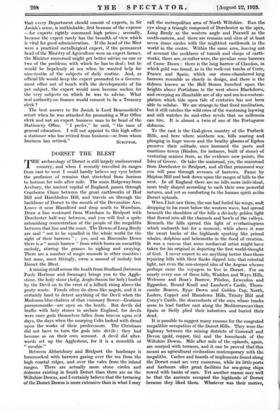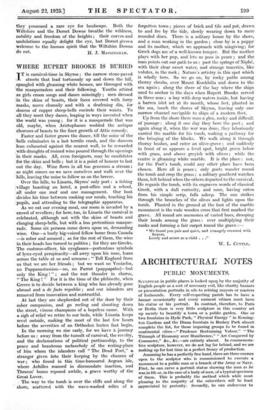DORSET THE BLEST
THE archaeology of Dorset is still largely undiscovered country, and when I recently travelled its ranges from east to west I could hardly believe my eyes before the profusion of remains that stretched from horizon to horizon for mile after mile. The main Ridgeway from Avebury, the ancient capital of England, passes through Cranborne Chase between the great earthworks of Hod Hill and Hambledon Hill, and travels on through the backbone of Dorset to the mouth of the Devonshire Axe. Leave it near Blandford and drop south to Wareham. Draw a line westward from Wareham to Bridport with Dorchester half-way between, and you will find a quite astonishing concentration of the people of the megaliths between that line and the coast. The Downs of Long Bredy are said " not to be equalled in the whole world for the sight of their barrows " ; yes, and on Bincombe Down there is a " music barrow " from which hums an unearthly melody,. stirring the grasses to sighing and swaying. There are a number of magic mounds in other counties : but none, most fittingly, owns a mound of melody but Dorset the Blest.
A musing stroll across the heath from Studland (between Poole Harbour and Swanage) brings you to the Aggle- stone, the holy stone (helig, Anglo-Saxon for holy) hurled by the Devil on to the crest of a hillock rising above the peaty waste. Fiends often do dress like angels, and it is certainly hard to detect anything of the Devil when the Madonna-blue chalices of that visionary flower—Gentiana pneumonanthe—are open on the heath. But devils did traffic with holy stones in archaic England, for devils were once gods themselves fallen from heaven upon evil .days, the days when the usurping Celts looked with dread upon the works of their predecessors. The Christians did not have to turn the gods into devils ; they had become so on their own account. A devil did after- wards set up the Agglestone, for it is a monolith or " menhir."
. Between Abbotsbury and Bridport the landscape is ,hummocked with ban.ows gazing over the sea from the high coastal ridges, and over the vales from the inland .ranges. There are actually- more stone circles and dolmens existing in South Dorset than there are on the Wiltshire Downs, and I certainly believe that the terracing of the Dorset Downs is more extensive than in what I may call the metropolitan area of North Wiltshire. Run the eye along a triangle composed of Dorchester as the apex, Long Bredy as the western angle and Poxwell as the south-eastern, and there are remains and sites of at least seven stone circles with the mightiest earthwork in the world in the centre. Within the same area, leaving out of account the necklaces of tumuli and clasps of earth- works, there are, or rather were, the peculiar cone barrows of Came Down : there is the long barrow of Clandon, in which gold was found, as in the rock-cut tombs of Crete, France and Spain, which our stone-chambered long barrows resemble so closely in design, and there is the dolmen known as the Hell. Stones hunched upon the heights above Portisham to the west above Blackdown,' and sweeping an illimitable arc of sky and sea in a contem- plation which tide upon tide of centuries has not been able to subdue. We are strange to that fixed meditation, but it still catches the wild cries of the wantoning lapwing and still watches its mid-ether revels that no millennia can tire. It is almost a twin of one of the Portuguese - dolmens.
To the east is the God-given country of the Purbeck Hills, and here where southern sea, hills soaring and plunging in huge waves and the heathy glooms of Egdon preserve their solitude, once hummed the ports and maritime towns (Bindon, for instance, built of stone) of venturing seamen from; as the evidence now points, the Isles of Greece. Or take the mainroad, yes, the mainroad from Dorchester to Bridport, and all that primrosed way you will pass through avenues of barrows. Pause by Shipton Hill and look down upon the ranges of hills to the west. In all England there are no hills more individual, more truly shaped according to each their own powerful natures, and yet so comforting to the human spirit as the Dorset uplands.
When I last saw them, the sun had furled his wings, ant dropping to his roost below the western wave, had spread beneath the shoulders of the hills a divinely golden light that flowed into all the channels and bowls of the valleys. Beneath the hills spread this light of everlastingness which endureth but for a moment, while above it rose the swart backs of the highlands sporting like primal whales, dolphins and behemoths in the flood of creation. It was a canvas that some mediaeval artist might have -taken for his original in depicting the first world-thought of God. I never expect to see anything better than those rejoicing hills with their flanks dipped into that celestial light, not even the sun-steeped isles of the Aegean whence perhaps came the voyagers to live in Dorset. For on nearly every one of these hills, Waddon and Ways Hills, Welcome and Boar's Barrow, Pilsdon,• Lewesdon and Eggardon, Round Knoll and Lambert's Castle, Thorn- combe Beacon, Eype Down and Golden Cap, North; Loders, Coppet and Hamdown Hills, Trinity Hill and Coney's Castle, the descendants of the men -whose tracks seem to lead further east along the Mediterranean than Spain or Sicily plied their industries and buried their dead.
It is possible to suggest many reasons for the congested megalithic occupation of the Dorset Hills. They were the highway between the mining districts of Cornwall and Devon (gold, copper, tin) and the homelands of the Wiltshire Downs. Mile after mile of the uplands, again, are scarped with terraces, and it can be proved that this meant an agricultural civilization contemporary with the megaliths. Caches and hoards of implements found along the Dorset coast are very numerous, while its little ports and harbours offer great facilities for sea-going ships- rowed with banks of oars. Yet another reason may well be that the ancients occupied the highlands of Dorset because they liked them. Whatever was their motive, they possessed a rare eye for landscape. Both the Wiltshire and the Dorset Downs breathe the wildness, nobility and freedom of the heights ; their curves and undulations equally delight the eye, but Dorset gives a welcome to the human spirit that the Wiltshire Downs



































 Previous page
Previous page